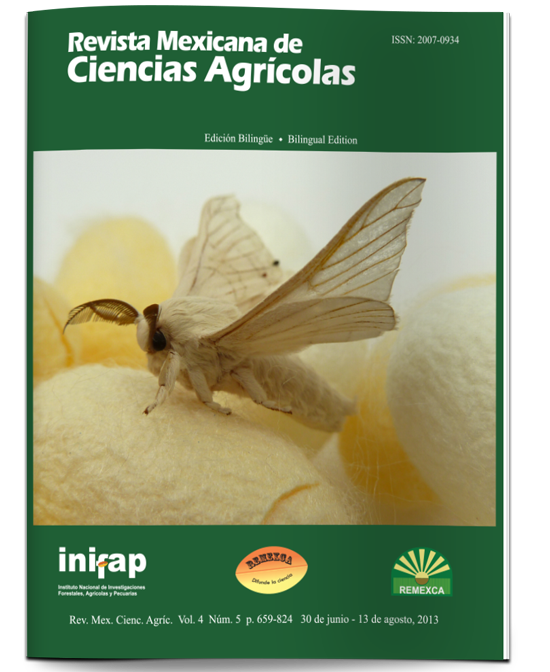Evaluation of mulberry varieties as feeding for silkworms (Bombyx mori) in Hidalgo, Mexico
DOI:
https://doi.org/10.29312/remexca.v4i5.1169Keywords:
Bombyx mori, Morus sp., Kinshu showaAbstract
The study was conducted in September 2011 in the laboratory for silkworms located at the Polytechnic University of Francisco I. Madero in the municipality of Francisco I. Madero, Hidalgo. A proximate analysis of three varieties of mulberry (Morus sp.) was performed: SLP5, SLP3 and Kanva. Using a completely randomized design with three treatments and two replicates, the varieties of mulberry were evaluated as feeding for 6 populations of 500 silkworm larvae (Bombyx mori) of the Kinshu Showa race. The effect of the feeding on technical and production indicators in the larval and pupal stages was assessed. We determined the proximate analysis components of mulberry leaves: dry matter, protein, fiber, ether extract and ash. In the larval stage we studied mortality, weight, length and thoracic diameter. In the pupal stage we analyzed the weight of the cocoon with and without chrysalis, the weight of the chrysalis, cocoon production, shape and size. The results of the proximate analysis indicate that the protein percentages in the three varieties are over 20%, with the SLP5 and Kanva varieties having the highest value, and the SLP3 variety the lower protein content (p> 0.05).In the larval stage, the larvae fed with the Kanva variety gained more weight, length and thoracic diameter; however, the populations fed with the SLP3 variety had a lower mortality rate, higher cocoon production, larger cocoons, and a larger amount of elliptical cocoons. The SLP5 variety produced heavier cocoons.
Downloads
Downloads
Published
How to Cite
Issue
Section
License
The authors who publish in Revista Mexicana de Ciencias Agrícolas accept the following conditions:
In accordance with copyright laws, Revista Mexicana de Ciencias Agrícolas recognizes and respects the authors’ moral right and ownership of property rights which will be transferred to the journal for dissemination in open access. Invariably, all the authors have to sign a letter of transfer of property rights and of originality of the article to Instituto Nacional de Investigaciones Forestales, Agrícolas y Pecuarias (INIFAP) [National Institute of Forestry, Agricultural and Livestock Research]. The author(s) must pay a fee for the reception of articles before proceeding to editorial review.
All the texts published by Revista Mexicana de Ciencias Agrícolas —with no exception— are distributed under a Creative Commons License Attribution-NonCommercial 4.0 International (CC BY-NC 4.0), which allows third parties to use the publication as long as the work’s authorship and its first publication in this journal are mentioned.
The author(s) can enter into independent and additional contractual agreements for the nonexclusive distribution of the version of the article published in Revista Mexicana de Ciencias Agrícolas (for example include it into an institutional repository or publish it in a book) as long as it is clearly and explicitly indicated that the work was published for the first time in Revista Mexicana de Ciencias Agrícolas.
For all the above, the authors shall send the Letter-transfer of Property Rights for the first publication duly filled in and signed by the author(s). This form must be sent as a PDF file to: revista_atm@yahoo.com.mx; cienciasagricola@inifap.gob.mx; remexca2017@gmail.
This work is licensed under a Creative Commons Attribution-Noncommercial 4.0 International license.



